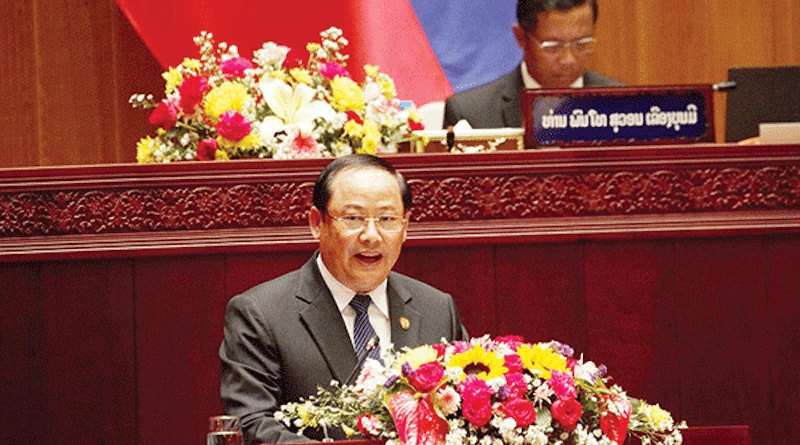Challenging Times Ahead For Laos’ New Prime Minister – Analysis
By Toshiro Nishizawa*
While rumours of former Lao prime minister Phankham Viphavanh’s premature resignation surfaced in mid-December 2022, it was only on 3 January 2023 that local media reported that Phankham had submitted a letter of resignation to President Thongloun Sisoulith, with the National Assembly having elected a new prime minister, Sonexay Siphandone, to succeed him.
Despite his unsuccessful handling of economic woes, some thought Phankham would not resign until the end of 2023, when his two-year timeframe for achieving his key policy agenda had passed. Presuming the early reshuffle would be interpreted as an admission of party leadership fault, Phankham resigned earlier than expected — either due to serious policy concerns or other political considerations.
Sonexay Siphandone’s premiership was nonetheless widely anticipated within Laos. His father, Khamtay Siphandone, served for 14 years as the leader of the ruling Lao People’s Revolutionary Party (LPRP) before stepping down in 2006. Aged 99, Khamtay is a symbolic figure within the party of his clan’s influence over its politics.
While the Lao economy will not fully recover in 2023, the worst is over unless unanticipated problems emerge. The economic policy environment will crawl towards pre-pandemic normalcy, with concerns about a heavy external debt burden continuing. The debt stock was projected to increase to over 100 per cent of GDP in 2022, and around half is owed to China.
While there won’t be any dramatic changes on the economic and social fronts, there is some possibility of improvement. The Lao economy appears resilient with signs of an incipient recovery after hitting a record low, as upward mobility trends suggest since early 2022.
Incremental economic recovery will continue as the impacts of external shocks gradually dissipate, not necessarily because of policy measures. The recent reversal of China’s zero-COVID policy reopened the Boten–Mohan international border crossing on 8 January 2023 and will help recover cross-border economic activity via the Laos–China railway.
Spillover effects of commodity price hikes and the Lao kip’s depreciation may persist over domestic prices for some time. But year-on-year inflation rates will decline towards the middle of 2023 from the upper-30 per cent range seen in the latter half of 2022. Supported by administrative interventions such as daily limits on foreign exchange transactions and closures of exchange bureaux, exchange rates remain around 17,000 kips per US dollar despite the gap between parallel rates.
While the Lao economy avoided a complete collapse despite pandemic-era adversities, the government and the LPRP must establish policy coherence to avoid discrepancies between political motives and economic rationalities.
One such discrepancy is the government issuing bonds with distorted terms to mobilise funds. Ten-year government bonds offered a 7.5 per cent kip coupon and an 8 per cent dollar coupon in December 2022 even under double-digit inflation pressures. On the other hand, the Lao central bank issued six-month bonds worth five trillion kip in June 2022 and one trillion kip in January 2023, with a 20 per cent coupon to reduce kip liquidity and ease depreciation pressures.
As a next-generation leader entrusted by senior party leaders, Sonexay Siphandone is expected to lead party technocrats in crucial cabinet positions. His premiership seems to reflect accelerated leadership rejuvenation attempts led by President Thongloun Sisoulith, with the consensus of the party’s inner circle.
There is good reason that Sonexay will be more responsive than his predecessor in minimising the risks of growing public discontent, especially by prioritising social protection measures for the most vulnerable, particularly in urban areas.
Low-income populations in urban areas without dollar assets have suffered the most from inflation, particularly when it comes to food items and daily necessities. Conversely, upper-income households may have gained by relying on dollar-denominated assets and ‘mattress money’. In September 2022, foreign currency deposits grew by 47 per cent to 114 trillion kip while local currency deposits remained around 47 trillion kip.
The Lao government needs to mobilise budgetary resources to address concerns about emerging public discontent. But fiscal revenues remain below pre-pandemic levels and continue to limit fiscal space, even with tightened expenditure.
Such narrow fiscal space requires the continued deferral of debt service payments to Chinese lenders. Services on public and publicly-guaranteed debt is projected to be US$1.4 billion in 2023 and will remain at an average of US$1.3 billion per year until 2026. More seriously, debt service deferral is a prerequisite to saving foreign exchange reserves, which stood at US$1.1 billion in September 2022, down from a recent peak of US$1.5 billion in June 2022.
In mid-January, Sonexay welcomed his counterpart from Vietnam, Prime Minister Pham Minh Chinh — the first foreign leader to see him. Sonexay’s next step will likely be to consolidate the political support of China.
The new prime minister’s first task should be to prioritise policy measures considering Laos’s limited fiscal space, before establishing policy coherence over the medium term and ensuring uninterrupted support from China on the debt front.
*About the author: Toshiro Nishizawa is Professor at the Graduate School of Public Policy, the University of Tokyo
Source: This article was published by East Asia Forum

